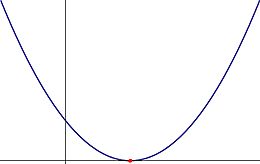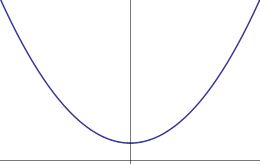Quadratic equation: Difference between revisions
imported>Aleksander Stos (copyedit) |
mNo edit summary |
||
| (18 intermediate revisions by 5 users not shown) | |||
| Line 1: | Line 1: | ||
{{subpages}} | {{subpages}} | ||
In [[mathematics]], or more specifically [[algebra]], a '''quadratic equation''' is | In [[mathematics]], or more specifically [[algebra]], a '''quadratic equation''' is an [[equation]] involving only [[polynomial]]s of the second degree. Quadratic equations are a common part of mathematical solutions to real-world problems in a huge variety of situations. Fortunately, there exists a simple closed formula for finding the [[root_(mathematics)|root]]s of such an equation, the '''quadratic formula''', involving no operation more advanced than taking the square root of a real number. | ||
Every polynomial equation can be put into the form: | |||
:<math>ax^2+bx+c=0</math> | |||
with ''a'', ''b'' and ''c'' real | :<math>ax^2+bx+c=0\,</math> | ||
with ''a'', ''b'' and ''c'' real and <math>a\not=0</math>. The quadratic formula specifies the roots of this equation as | |||
:<math>x=\frac{-b\pm\sqrt{b^2-4ac}}{2a}\ .</math> | :<math>x=\frac{-b\pm\sqrt{b^2-4ac}}{2a}\ .</math> | ||
Here, there are actually two roots being given, although the notation obscures this somewhat. One root is obtained by replacing the <math>\pm</math> appearing in the formula by a ''+'' sign, and the other is obtained by replacing it with a ''-'' sign. The formula is guaranteed to work for all quadratic polynomials, but sometimes the roots will be [[complex number]]s even when every other part of the problem deals only with [[real number]]s. Looking at the quadratic formula, we see that the roots will be complex precisely when the [[discriminant of a polynomial|discriminant]] <math>\Delta = b^2 - 4ac </math> is negative. | |||
There are other less frequently used techniques for solving quadratic equations. [[Completing the square]] is just as general as the quadratic formula (in fact, it is used to derive the formula below). Otherwise, if the polynomial has no linear term, or if it is easy to [[factor]], there are faster methods than using the quadratic formula. | |||
In this article, we are assuming as above that the coefficients of the quadratic polynomial are real. Quadratic equations can occur involving many other types coefficients, and the quadratic formula, interpreted correctly, can be applied in many of these other situations as well. See the [[quadratic equation/Advanced|advanced subpage]] for information about these more general quadratic equations. | |||
==Quadratic equations in applications == | |||
==The problem== | ==The problem== | ||
| Line 14: | Line 23: | ||
where <math>a</math>, <math>b</math>, and <math>c</math> are real constants and <math>a</math> is not zero (if it was, the polynomial | where <math>a</math>, <math>b</math>, and <math>c</math> are real constants and <math>a</math> is not zero (if it was, the polynomial | ||
would only be first-degree). | would only be first-degree). | ||
The [[graph]] of the [[function]] <math>f(x) = ax^2 + bx + c</math> a [[parabola]], and the roots that the quadratic equation will give us are the values of <math>x</math> at which the parabola crosses the <math>x</math>-axis. | |||
This means that the roots of the polynomial are the particular values of <math>x</math> for which the polynomial | This means that the roots of the polynomial are the particular values of <math>x</math> for which the polynomial | ||
equals zero. | equals zero. | ||
| Line 29: | Line 36: | ||
:<math>x_\pm=\frac{-b\pm\sqrt{b^2-4ac}}{2a}\ .</math> | :<math>x_\pm=\frac{-b\pm\sqrt{b^2-4ac}}{2a}\ .</math> | ||
Looking at the above result it is clear that the | Looking at the above result, it is clear that the discriminant <math>\Delta= b^2-4ac</math> | ||
is of interest | is of interest for two reasons. First it is the part of the solution that is either positive or negative depending on whether you are looking at the root | ||
<math>x_+</math> or <math>x_-</math>, so it | <math>x_+</math> or <math>x_-</math>, so it determines whether there are two different roots or just one. Second it is under a [[square root]], so we must wonder what happens when it is negative. | ||
This gives us three cases to look at. | This gives us three cases to look at. | ||
| Line 61: | Line 68: | ||
:<math>\begin{align}ax_\pm^2+bx_\pm+c | :<math>\begin{align}ax_\pm^2+bx_\pm+c | ||
&=a\left(\frac{-b\pm\sqrt{b^2-4ac}}{2a}\right)^2+b\frac{-b\pm\sqrt{b^2-4ac}}{2a}+c \\ | &=a\left(\frac{-b\pm\sqrt{b^2-4ac}}{2a}\right)^2+b\frac{-b\pm\sqrt{b^2-4ac}}{2a}+c \\ | ||
&=\frac{1}{4a}\left(b^2\ | &=\frac{1}{4a}\left(b^2 \mp 2b\sqrt{b^2-4ac}+b^2-4ac\right)-\frac{b^2\mp b\sqrt{b^2-4ac}}{2a}+c \\ | ||
&=\frac{b^2\ | &=\frac{b^2\mp b\sqrt{b^2-4ac}}{2a}-c-\frac{b^2\mp b\sqrt{b^2-4ac}}{2a}+c \\ | ||
&=0\ , | &=0\ , | ||
\end{align} | \end{align} | ||
| Line 70: | Line 77: | ||
== Derivation of the quadratic formula == | == Derivation of the quadratic formula == | ||
To derive the quadratic formula stated above, we must start with the quadratic equation | To derive the quadratic formula stated above, we must start with the quadratic equation | ||
:<math>ax^2+bx+c=0</math> | :<math>ax^2+bx+c=0\,</math> | ||
and then [[completing the square|complete the square]]. We | and then [[completing the square|complete the square]]. We begin by subtracting <math>c</math> from and then multiplying both sides by <math>4a</math>, to obtain | ||
:<math>\left( | |||
: <math>4a^2 x^2 + 4abx = -4ac. \,</math> | |||
:<math> | |||
As written, the left side does not factor in a useful way. The trick is to add <math>b^2</math> to both sides, because afterward the left side will factor as a complete square: | |||
</math> | :<math>\left(2ax+b \right)^2= b^2-4ac .\,</math> | ||
Finally we | |||
:<math>x=\frac{-b\pm\sqrt{b^2-4ac}}{2a} | We now take the square root of both sides, remember that there will be two possible square roots for of the number on the right side, indicated by the <math>\pm</math> symbol: | ||
:<math> 2ax + b = \pm \sqrt{b^2-4ac}. </math> | |||
Finally, we solve for <math>x</math> to obtain | |||
:<math> x = \frac{-b \pm \sqrt{b^2-4ac}}{2a}</math>, | |||
which is the quadratic formula.[[Category:Suggestion Bot Tag]] | |||
Latest revision as of 16:01, 8 October 2024
In mathematics, or more specifically algebra, a quadratic equation is an equation involving only polynomials of the second degree. Quadratic equations are a common part of mathematical solutions to real-world problems in a huge variety of situations. Fortunately, there exists a simple closed formula for finding the roots of such an equation, the quadratic formula, involving no operation more advanced than taking the square root of a real number.
Every polynomial equation can be put into the form:
with a, b and c real and . The quadratic formula specifies the roots of this equation as
Here, there are actually two roots being given, although the notation obscures this somewhat. One root is obtained by replacing the appearing in the formula by a + sign, and the other is obtained by replacing it with a - sign. The formula is guaranteed to work for all quadratic polynomials, but sometimes the roots will be complex numbers even when every other part of the problem deals only with real numbers. Looking at the quadratic formula, we see that the roots will be complex precisely when the discriminant is negative.
There are other less frequently used techniques for solving quadratic equations. Completing the square is just as general as the quadratic formula (in fact, it is used to derive the formula below). Otherwise, if the polynomial has no linear term, or if it is easy to factor, there are faster methods than using the quadratic formula.
In this article, we are assuming as above that the coefficients of the quadratic polynomial are real. Quadratic equations can occur involving many other types coefficients, and the quadratic formula, interpreted correctly, can be applied in many of these other situations as well. See the advanced subpage for information about these more general quadratic equations.
Quadratic equations in applications
The problem
Any real second-degree polynomial in the variable will be of the form
where , , and are real constants and is not zero (if it was, the polynomial would only be first-degree). The graph of the function a parabola, and the roots that the quadratic equation will give us are the values of at which the parabola crosses the -axis. This means that the roots of the polynomial are the particular values of for which the polynomial equals zero.
The problem that the quadratic formula solves is to find those roots.
The solution
The Fundamental Theorem of Algebra tells us that we should expect there to be two roots for a second-degree polynomial, although they might be equal in some cases, and may not be real even when the coefficients and variable are. If we call the roots and then what we are saying is that we have the quadratic equation
This is where the quadratic formula comes in. It tells us that the solutions and can always be found as
Looking at the above result, it is clear that the discriminant is of interest for two reasons. First it is the part of the solution that is either positive or negative depending on whether you are looking at the root or , so it determines whether there are two different roots or just one. Second it is under a square root, so we must wonder what happens when it is negative. This gives us three cases to look at.
Here we have two distinct real roots, since the square root of will also be real and greater than zero, meaning that we have
and
These can be seen graphically as the two red dots in Figure 1. In this case we can rewrite the polynomial in terms of its roots as
and it is easy to see that indeed if we set or then the polynomial well be equal to zero.
Now there is only one distinct root. It is still real, and is said to have a multiplicity of 2. This is because the root is given by
and the polynomial can be expressed as
This case occurs when the parabola described by the polynomial just touches the -axis at exactly one point, the red dot shown in Figure 2. Again, setting in the polynomial makes it vanish.
For negative values of the discriminant there are no real roots to the polynomial. Graphically this corresponds to the situation where the lowest point on the parabola is above the -axis (or the highest point is below it, if is negative) as shown in Figure 3. In this case the roots still exist, as guaranteed by the fundamental theorem of algebra, but they are complex so cannot be shown on the real number line.
Proof
The simplest way to show that the values are in fact roots to the polynomial above is to substitute them into the equation
as desired. Notice that this proof is valid even in the case where is less than zero.
Derivation of the quadratic formula
To derive the quadratic formula stated above, we must start with the quadratic equation
and then complete the square. We begin by subtracting from and then multiplying both sides by , to obtain
As written, the left side does not factor in a useful way. The trick is to add to both sides, because afterward the left side will factor as a complete square:
We now take the square root of both sides, remember that there will be two possible square roots for of the number on the right side, indicated by the symbol:
Finally, we solve for to obtain
- ,
which is the quadratic formula.





































